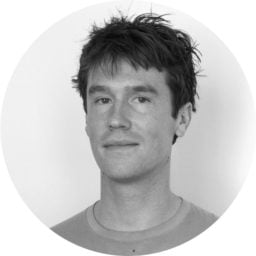Art & Exhibitions
‘People Are Lonely’: Terence Koh’s New Project Is the Ultimate Anti-Spectacle–He’s Serving Coffee in L.A.
Under an earthen dome, Koh sits at a tiny campfire boiling his brew.
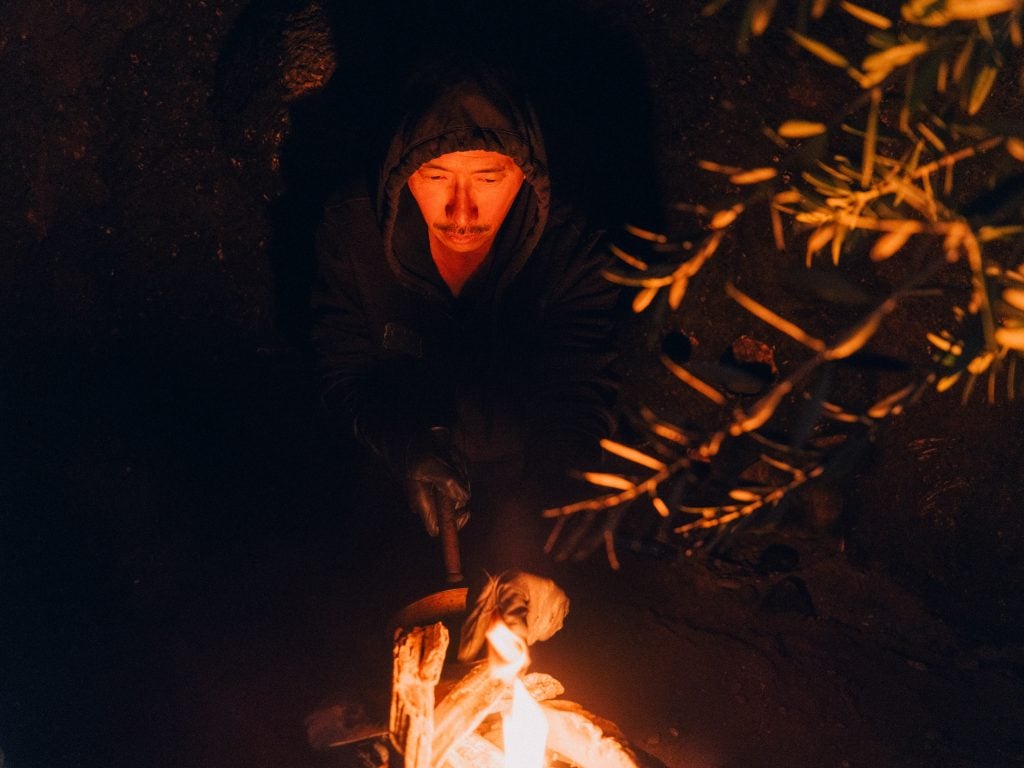
“I was drinking like eight coffees a day trying to figure this out,” Terence Koh was telling me last month, knelt over a portable burner in an empty micro gallery that would become his installation called KOHFEE. “Thinking about my move to L.A. and all these things, thinking about what the world needs right now… I don’t think the world needs another coffee shop.” I totally agree, and yet, was he on a journey to make one?
A trail of handwritten pencil notes, transmitted as jpegs via text, had led me to this meeting with the inscrutable Xennial artist. They were sent by Koh with his signature flourishes like “2morrow” and a doodle of an eye in the place of the word “I.” For those who don’t know, Koh was one of the highest profile artists in New York City in the aughts—alongside other Lower East Side royals like Dash Snow, Ryan McGinley, and Dan Colen. That was before he began to pull away from the spotlight, a move roughly timed to the ascent of Instagram.
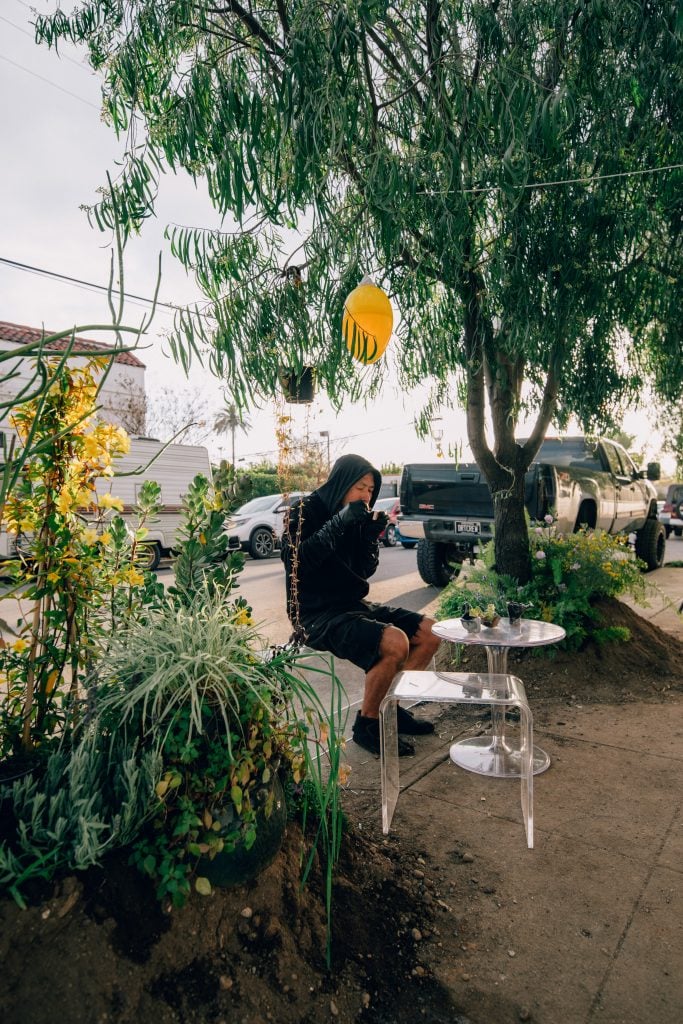
Artist Terence Koh outside his installation. Image courtesy the artist and Make Room, Los Angeles. Photographer: Nice Day Photo
Now on view through March 29 at Make Room, a commercial gallery tucked away on predominantly residential Waring Avenue between Hollywood and Hancock Park, “KOHFEE” offers an experience very different from the oppressively neutral aesthetics of cafes clad in cedar or Moroccan tiles and abuzz with loneliness.
KOHFEE smells different, too: over the past month or so, Koh has transformed the alcove project space into a cave for coffee rituals whose floors, walls, and ceilings are held together by a mixture of raw earth and cow dung. The glaring daylight visible from the only window onto the space feels centuries away when you are kneeling under the earthen dome on the far side of the little room, huddled around Koh’s tiny campfire where he boils his brew.
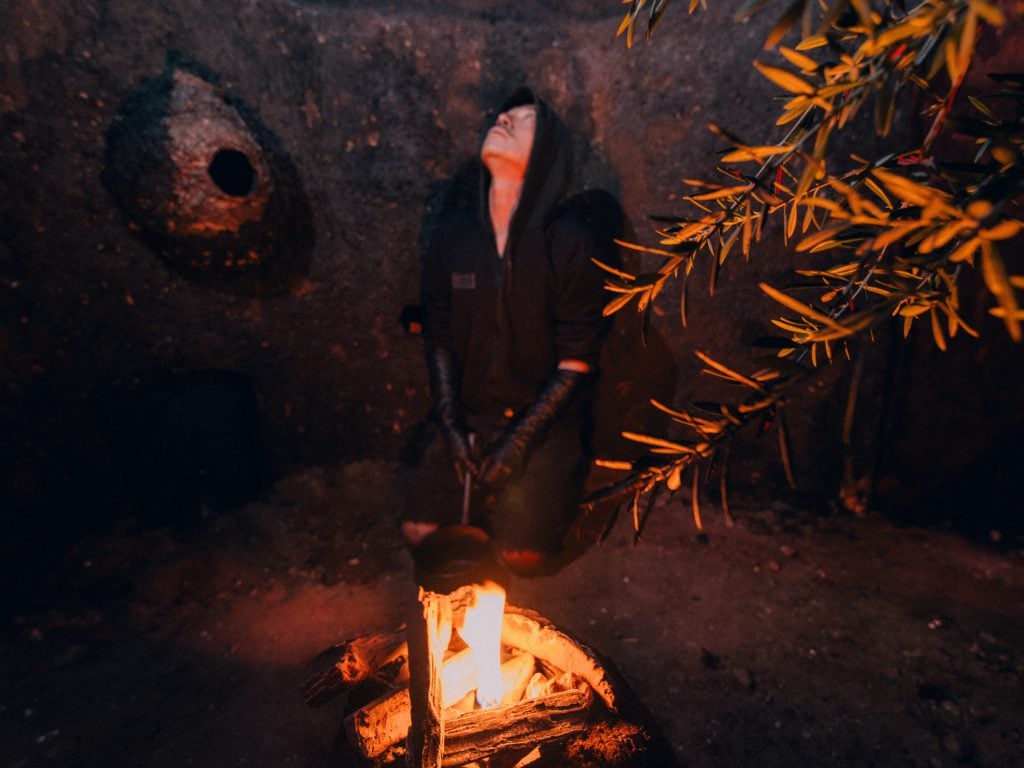
Artist Terrence Koh. Image courtesy the artist and Make Room, Los Angeles. Photographer: Nice Day Photo
“It seemed ridiculous at first to do a coffee shop, but then, after I thought about how it’s a part of L.A. culture— like [the] sun and everything and how everybody seems like, ‘You know what? Let’s go grab a cup of coffee’—it’s a very positive thing for most people to come and gather,” Koh continued. “People let their guard down very quickly when I tell them it’s just like a simple coffee shop instead of an installation. I’m always joking that it’s almost like a serious art installation hidden inside a coffee shop.”
The last time I interviewed Koh about his work was in 2016, when he was exhibiting an installation called Bee Chapel in galleries on both U.S. coasts—the work consisted of a domed room of proportions similar to the KOHFEE, with an infrastructure that allowed proximity to the thousands of bees Koh had begun beekeeping since leaving Manhattan for the Catskills.
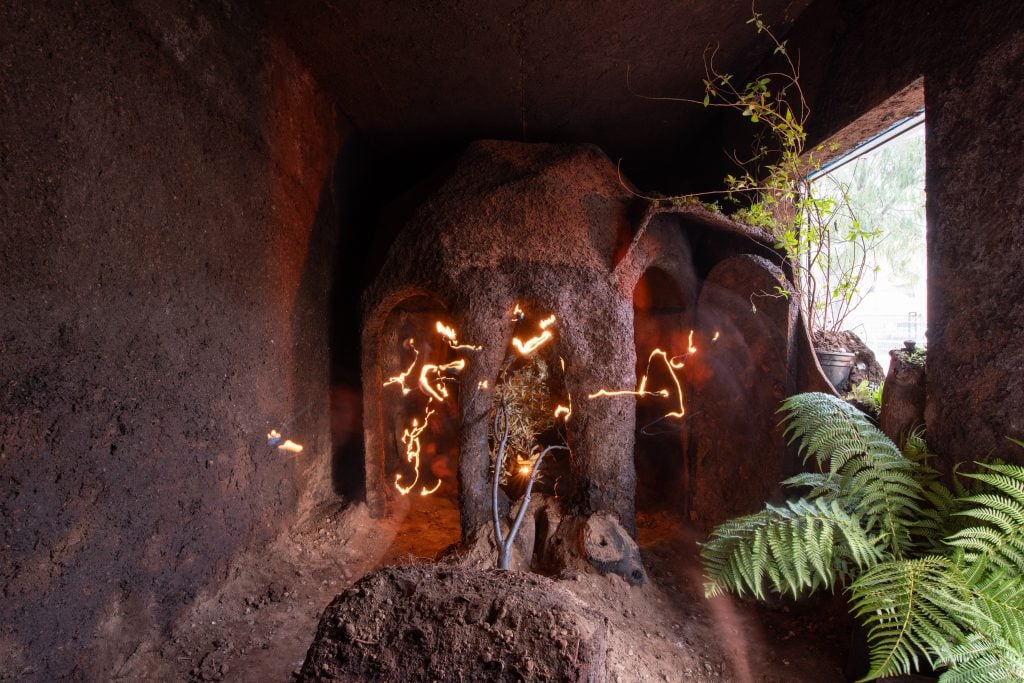
An interior view of KOHFEE. Image courtesy the artist and Make Room, Los Angeles. Photographer: Nice Day Photo
Since then he has had a handful of shows in the U.S. and Europe, including one at Office Baroque in Antwerp that incorporated larger features of this current project—an earth-covered room and campfire. More recently, he had a show at Andrew Edlin Gallery in New York last year, whose press release was a handwritten decree similar in style to the texts I received, promising:
for
the next
few
ears
eye
will
dedicate my life too a single body of work
no piece will bee larder than the size of the
human heart
—signed and dated, “24 dec ’22, lost angels.”
Born in Beijing and raised in Mississauga, Canada, Koh came up in post-9/11 New York as the pseudonymic asianpunkboy, publishing an eponymous zine which is now on view in the Brooklyn Museum’s Copy Machine Manifestos: Artists Who Make Zines exhibition, through March 31.
As asianpunkboy, he began exhibiting his work at Peres Projects’s original Los Angeles location in 2003. By 2007, his art career (and market) had feverish momentum and the media had begun to canonize him as a deity of sublime excess—a characterization that found some congruence with the content of his work. His first American solo museum show, which opened as part of the Whitney Biennial that winter, was a blinding 4000-watt lamp that turned on a black orb, set in an otherwise empty and all-white gallery on the ground floor of the Breuer Building.
A few months prior to that, Koh had moved into a three-story party palace at 45 Canal Street—in what is now the heart of Dimes Square, standing between Cervo’s and Dimes cafe—where he opened his own art gallery called ASS (Asia Song Society). By Art Basel Miami Beach of that year, he famously declared “I am the Naomi Campbell of Art” and also claimed that he intended to retire from art in the coming year.
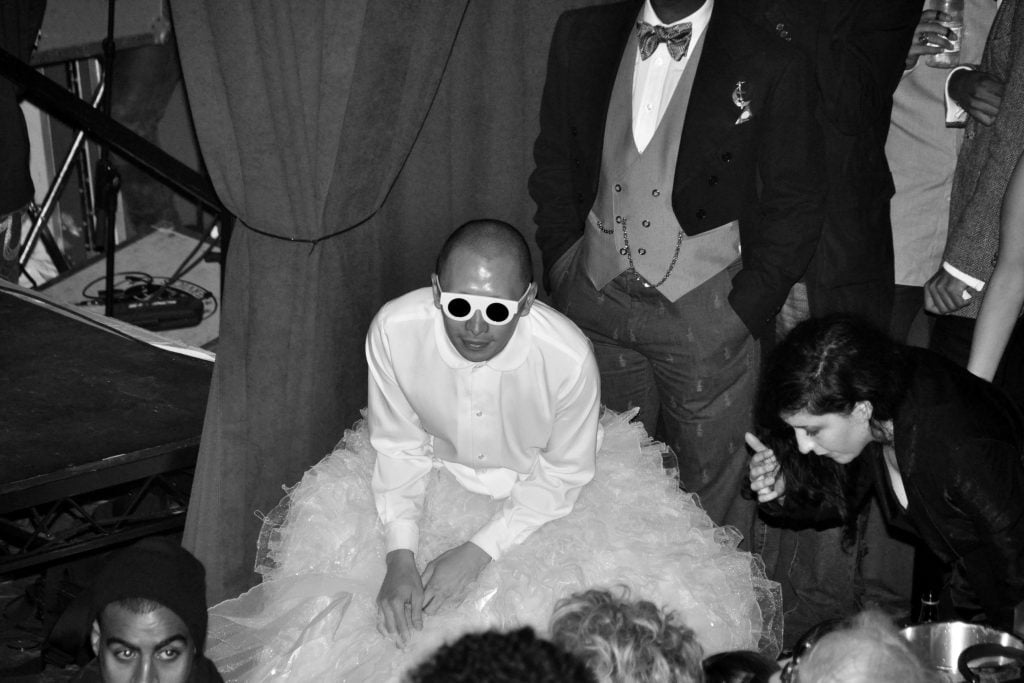
Terence Koh in 2010 in New York City. Photo: Marie Havens/Patrick McMullan via Getty Images
Nevertheless, his art career continued to evolve and so did his fame. By 2010, he was not only an art star, but he was also in the headlines for things like helping Oprah coax a distraught Lady Gaga out of her dressing room at the Met Gala. That year he collaborated with Gaga on performances at the Grammy’s, an Amfar Gala, and a charity event in Tokyo. Then, in 2014, Koh left New York City. The mythologizing of how Koh quit the art world began.
“You are the first person drinking coffee,” Koh told me, grinning. “I just realized you are the first customer in this place, and it is gonna be so different because it’s such a mess right now, but I think that’s the fun part.”
Some artists seem practiced in pantomiming childlike excitement about their work for their audiences, but in Koh’s case it feels completely sincere. The fact that this project is more humble in scale than many of the outrageous creations that precede it seems irrelevant. “The next few weeks I’m really trying different oils and things that will go well together with herbs to make a coffee that’s very… very simple but also earthy… we might have milk options outside in pitchers,” he tells me before seeming to change his mind. “Or maybe no options of creamers. It’s a coffee shop, but there’s only one choice, and we don’t give you the option, and it’s free.”
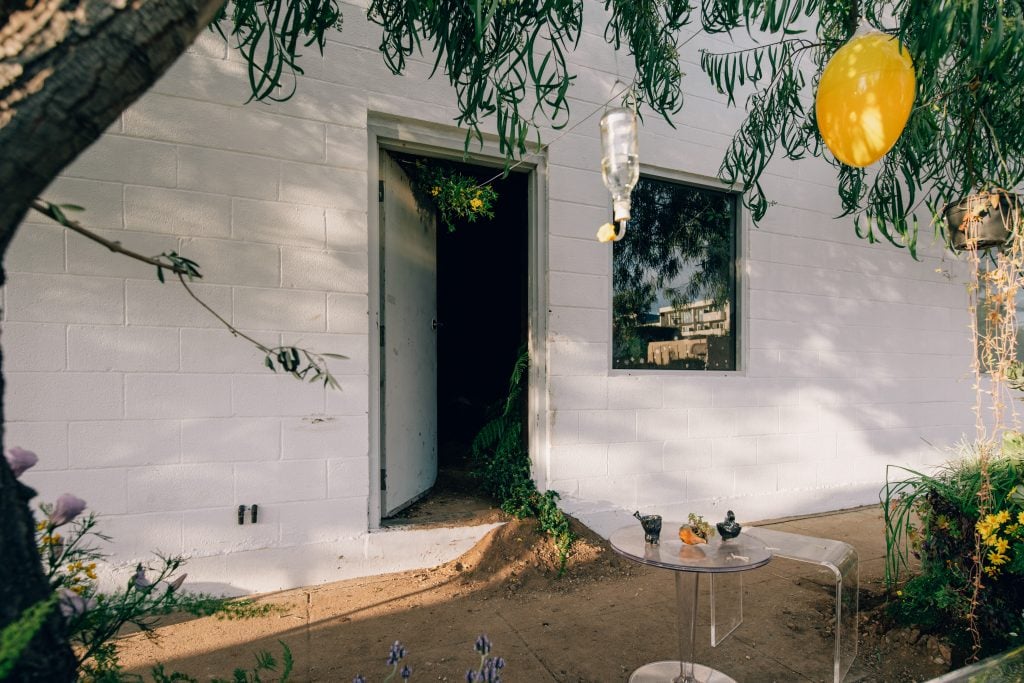
Terence Koh’s KOHFEE. Image courtesy the artist and Make Room, Los Angeles. Photographer: Nice Day Photo
On the day of the opening in February, a small line of patrons hugged the wall outside the door to the cave. Koh escorted groups of three or four of them at a time into the chamber; the event was a marathon of small coffee ceremonies where, each time, Koh held a heavy blackened pot over a small flame and grated and stirred various ingredients into the mixture. Once each batch was ready, he haphazardly poured it over a cluster of Dixie cups, spilling plenty of what was sparse to begin with. At one point, he mentioned something to the effect that spilling is an aspect of Chinese hospitality. (Outside the rush of the opening, during the project’s regular hours, coffee is served in ceramic cups Koh made himself.)
Personally, I was into the hippie brutalism of the experience. Everything about this project revolves around smallness and quiet: an anti-spectacle where nothing is for sale. I liked sitting on dirt and I enjoyed the taste and texture of a weird coffee-based potion with traces of plant sediment in it. I didn’t see God, but it was simple and special. Three women dressed like art collectors were conspicuously positive about how amazing they found the coffee to be. Someone told me they saw one of them sip theirs and then throw the rest on the street before saying how much she loved it. While Koh certainly has said nothing to suggest that his cafe is a social experiment, part of me wonders if it is in some way some kind of game.
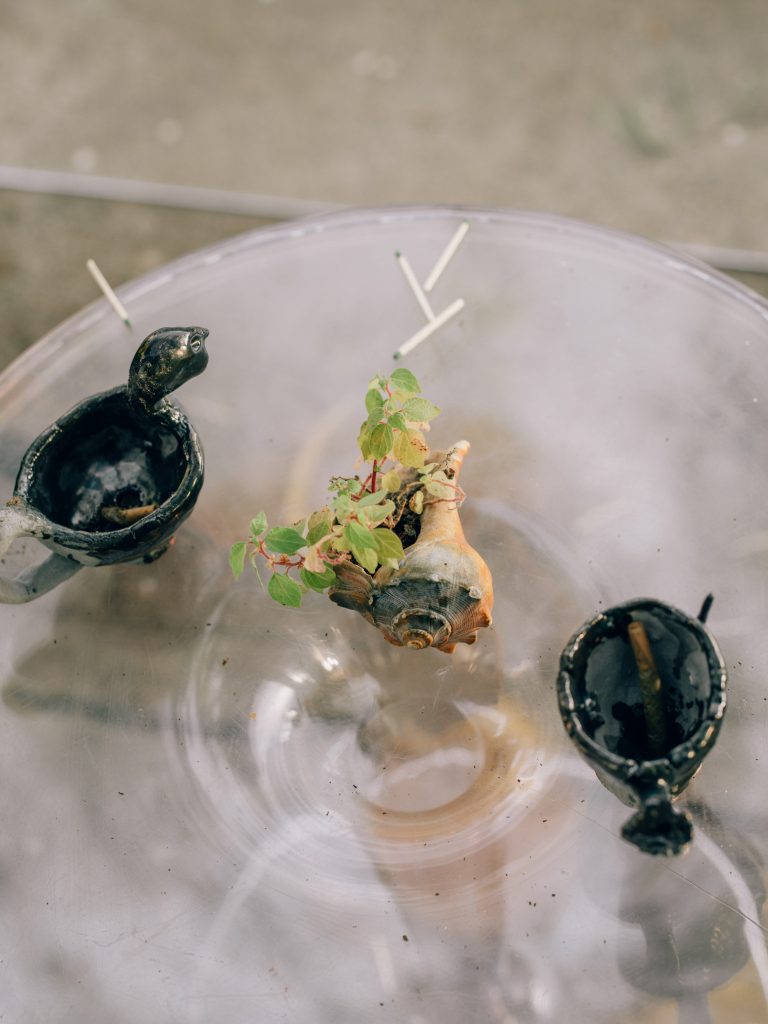
Terence Koh’s handmade tea cups. Image courtesy the artist and Make Room, Los Angeles. Photographer: Nice Day Photo
Koh’s original talent was always weaving enigmas, and I don’t believe he has much control over the fact that he’s a pop star, but this circumstance gives him superhuman license to blur the lines between art and life. When stars retreat from public life, they remain stars and, in fact “retreating from public life” is something only a star can do. It would be disingenuous to say that KOHFEE is an art world comeback for Koh. For one thing, there’s no way out of the pantheon once you’re in it—as evidenced by the routine reports of his comings and goings from retirement (like Cher), despite the fact he has actually maintained a studio practice consistently since the start.
As I waited for my first cup back in February, Koh rejoiced suddenly—”Nice, it kind of works…yay!”—as the water tossed into the pot loudly sizzled. “Loneliness and solitude are two different things. Solitude is a beautiful thing. I’m starting to learn that and appreciate that you can have solitude in L.A., and then go and be social when you want. But I think I miss [how] when you step out onto the street in New York City, you bang right onto humanity and human vibration,” he said while simultaneously adding that he was not moving back to New York. “We do innately need that, to connect with humans physically and not through the screen. And in L.A. people are lonely, and they connect through coffee shops.”

